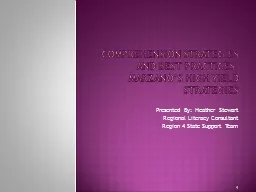

marzanos High yield strategies Presented By Heather Stewart Regional Literacy Consultant Region 4 State Support Team 1 How kids learn Visualizing Handson Modeling Conferencing Reading ID: 694092
Download Presentation The PPT/PDF document "Comprehension Strategies and best practi..." is the property of its rightful owner. Permission is granted to download and print the materials on this web site for personal, non-commercial use only, and to display it on your personal computer provided you do not modify the materials and that you retain all copyright notices contained in the materials. By downloading content from our website, you accept the terms of this agreement.
Slide1
Comprehension Strategies and best practices: marzano’s High yield strategies
Presented By: Heather StewartRegional Literacy ConsultantRegion 4 State Support Team
1Slide2
How kids learn
VisualizingHands-onModelingConferencingReading
Making connections
Schema
Prior knowledgeGraphic organizersLearning Depends on the Student!!!!!
2Slide3
Five Premises Basic to Reading Comprehension
Reader constructs meaning by making connections between new information and what is already knownPrior knowledge plays an important role in learningReading and writing are connectedLearning is a socially interactive processComprehension is dependent on METACOGNITION
3Slide4
Best practicesLesson Protocol
Data DrivenStandards-basedScaffoldingZone of Proximal DevelopmentDifferentiated InstructionUDL PrincipalsLevels of Engagement
Assess-Plan-Teach-Reflect
4Slide5
Marzano’s researchEffects of instruction on student learning
Identifying those strategies that have the highest probability of enhancing student achievementTeacher has the control
5Slide6
Nine high yield strategiesIdentifying Similarities and Differences
Summarizing and Note-TakingReinforcing Effort and Providing RecognitionHomework and PracticeNonlinguistic RepresentationsCooperative LearningSetting Objectives and Providing Feedback
Generating and Testing Hypothesis
Questions, Cues, and Advance Organizers
6Slide7
Leading questions
What are we doing?Why are we doing it?How do we do it well?
7Slide8
Identifying similarities and differences
Give students a model for the processUse familiar content to teach students the steps for comparingGive students graphic organizers for comparingGuide students as needed
8Slide9
Summarizing and note taking
SummarizingTeaching students rules-based strategiesUsing summary framesModelingThink aloud
Note Taking
Variety of formats
Teacher prepared notesTime for review
9Slide10
Reinforcing effort and providing recognition
Teaching students that effort can improve achievementAsk students to chart effort and achievementIntrinsic vs. extrinsic reinforcementsWhat works for one may not work for all
10Slide11
Homework and practiceEstablishing and communicating a homework policy
Clarifying the purpose of homeworkAsking students to use homework assignment sheetsCommenting on homeworkIndependence!!!
11Slide12
Nonlinguistic representations
Graphic organizersPictographic representationsMental imagesPhysical modelsKinesthetic representations
12Slide13
Cooperative learningPositive interdependence
Face-to-face promotive interactionIndividual and group accountabilityInterpersonal and small group skillsGroup processing
13Slide14
Setting objectives and providing feedback
Setting objectives that are not too specificPersonalizing objectivesCommunicating objectivesUsing criterion-referenced feedback and explanationsEngaging students in peer feedbackAsking students to self-assess
14Slide15
Generating and testing hypothesis
Applying KnowledgeSix different types of tasks systems analysis problem solving decision making historical investigation
experimental inquiry
invention
15Slide16
Questions, cues, and advance organizers
Before-During-After Reading“Front Loading”Focus on what is important, NOT what is unusualFocus on “higher level” questions
16Slide17
Key ideasInstructional implications
Student engagementLiterate environmentHigher level thinking skillsTechnology integrationDifferentiationData driven
17Slide18
resources
Marzano, Robert J. Classroom Instruction that Works: Research-Based Strategies for Increasing Student Achievement. ASCD, Alexandria, Virginia. 2001.
Lake/Geauga County Educational Service Center Website
http://www.lcesc.k12.oh.us/
Heather Stewart’s Literacy Website
http://stewartsliteracynet.weebly.com/
18